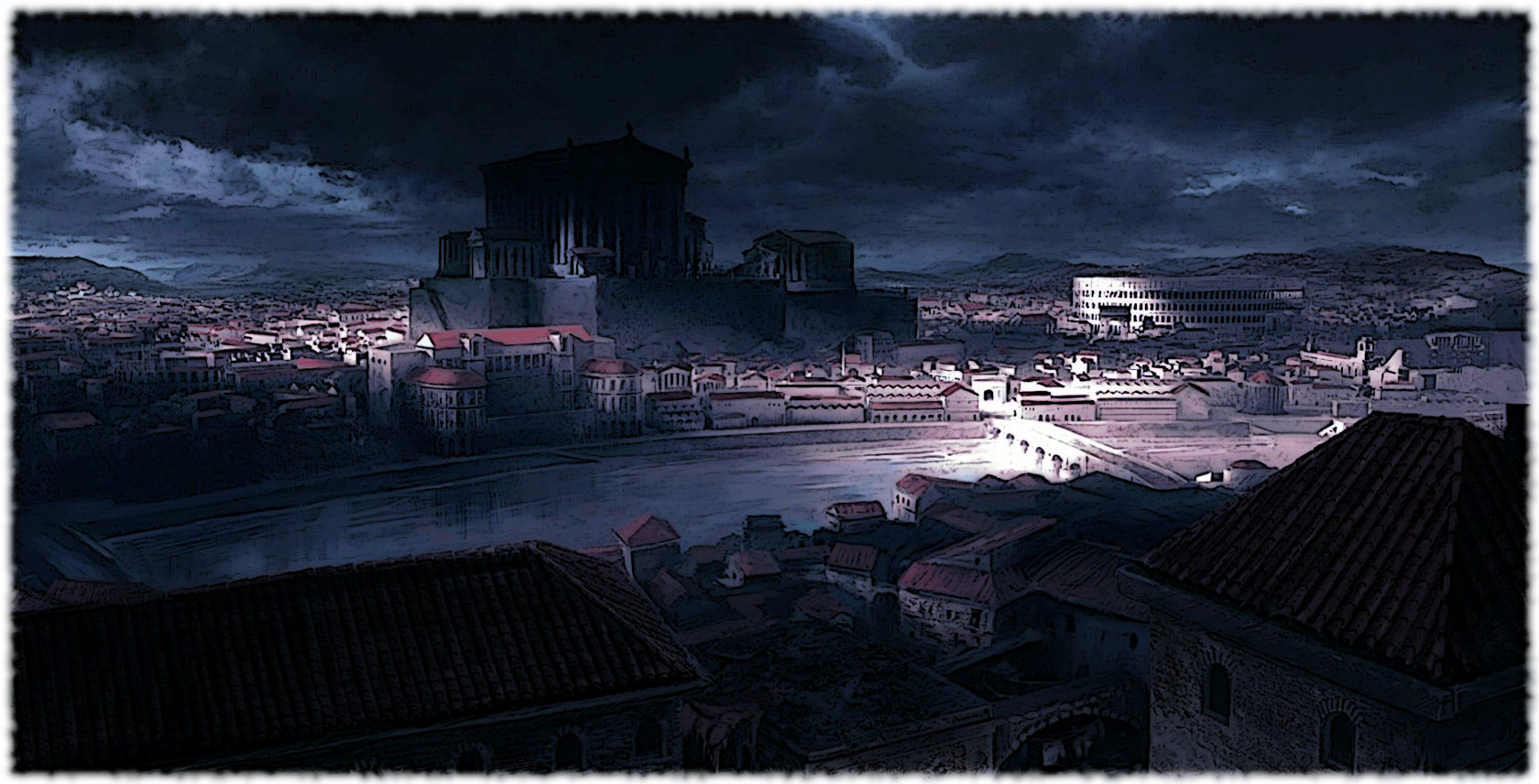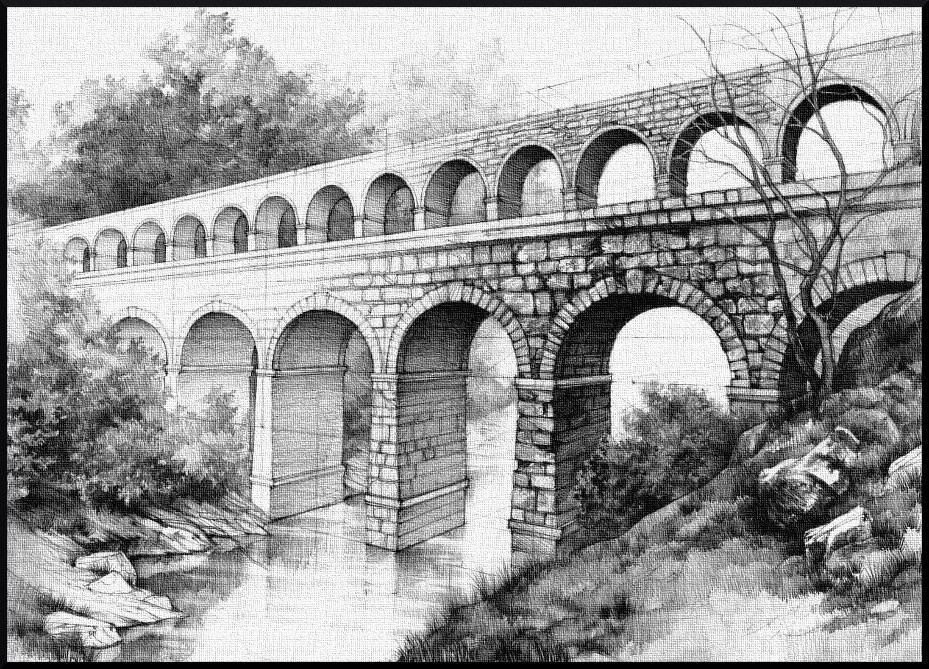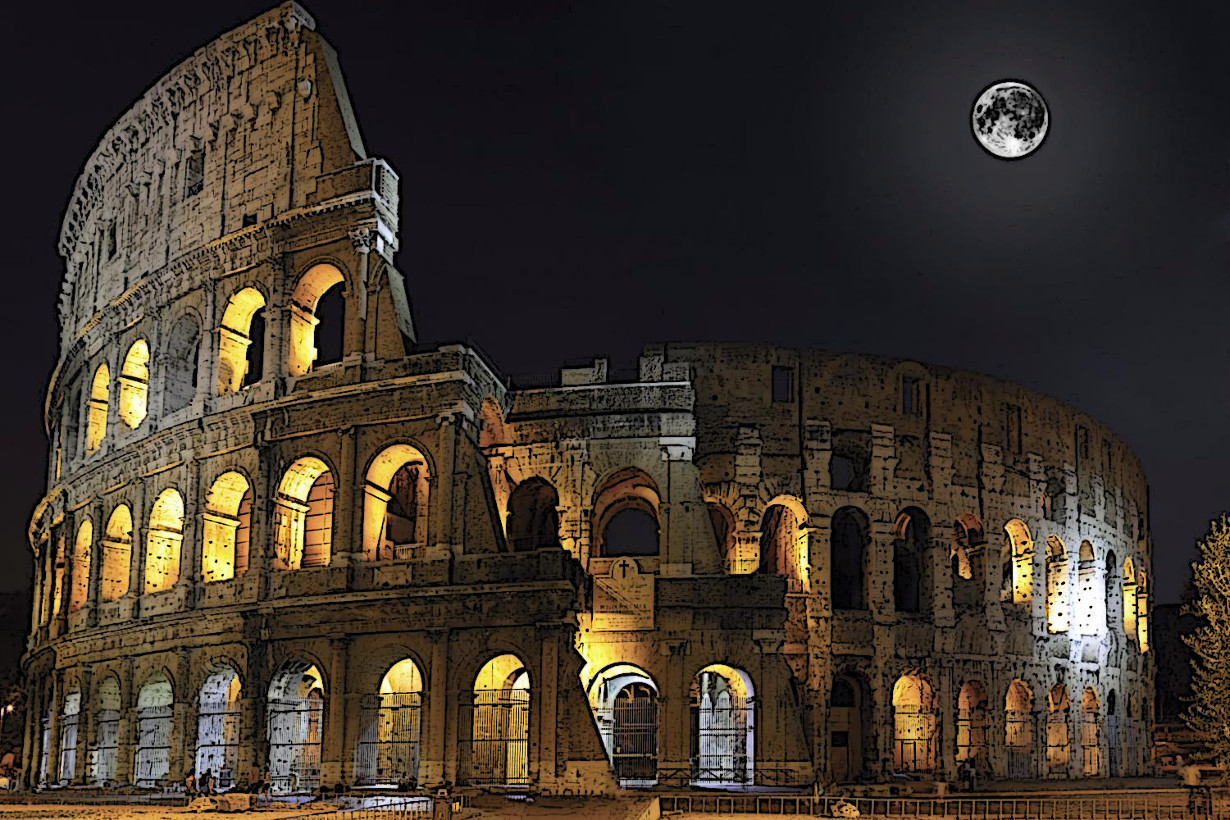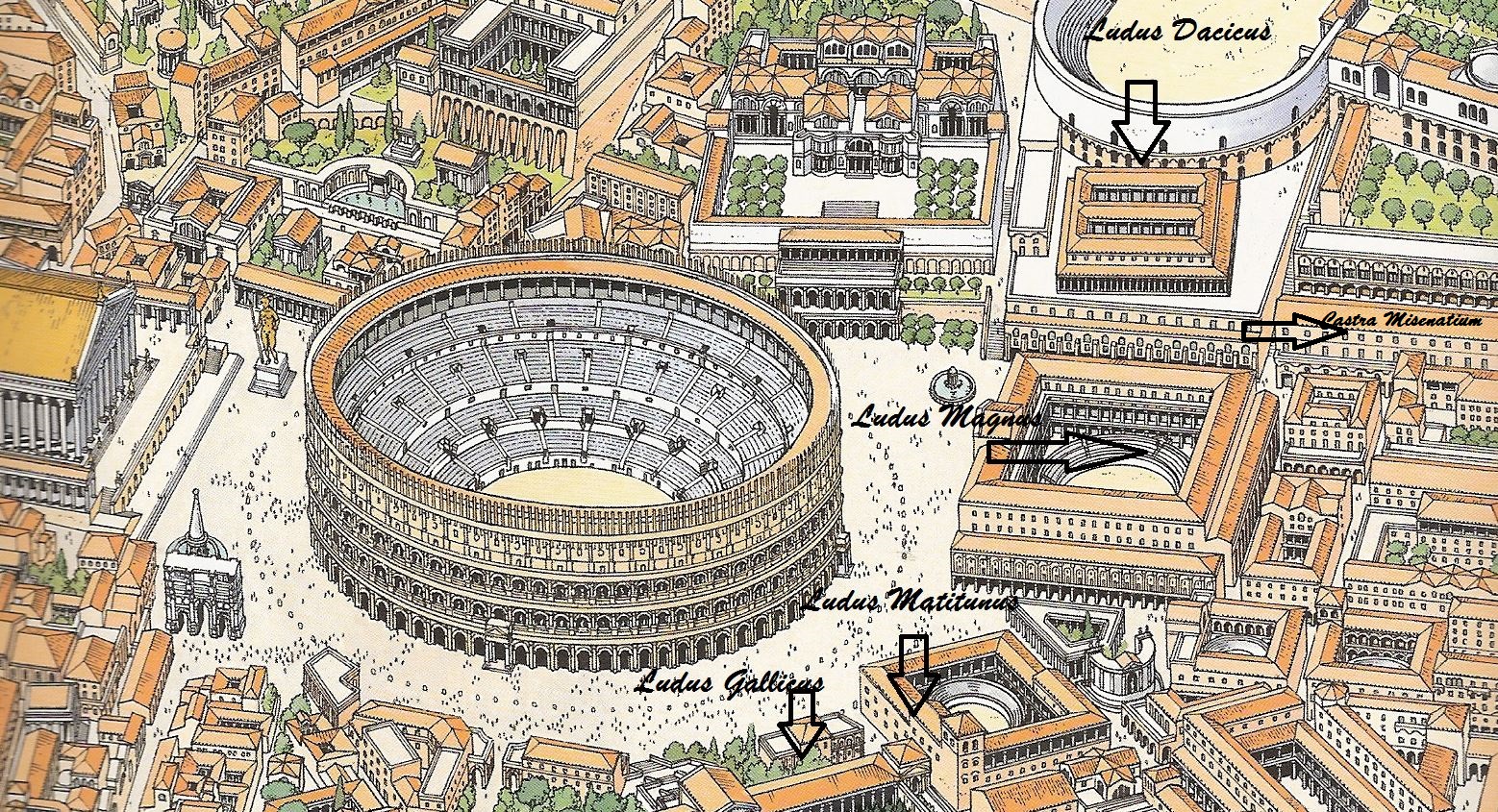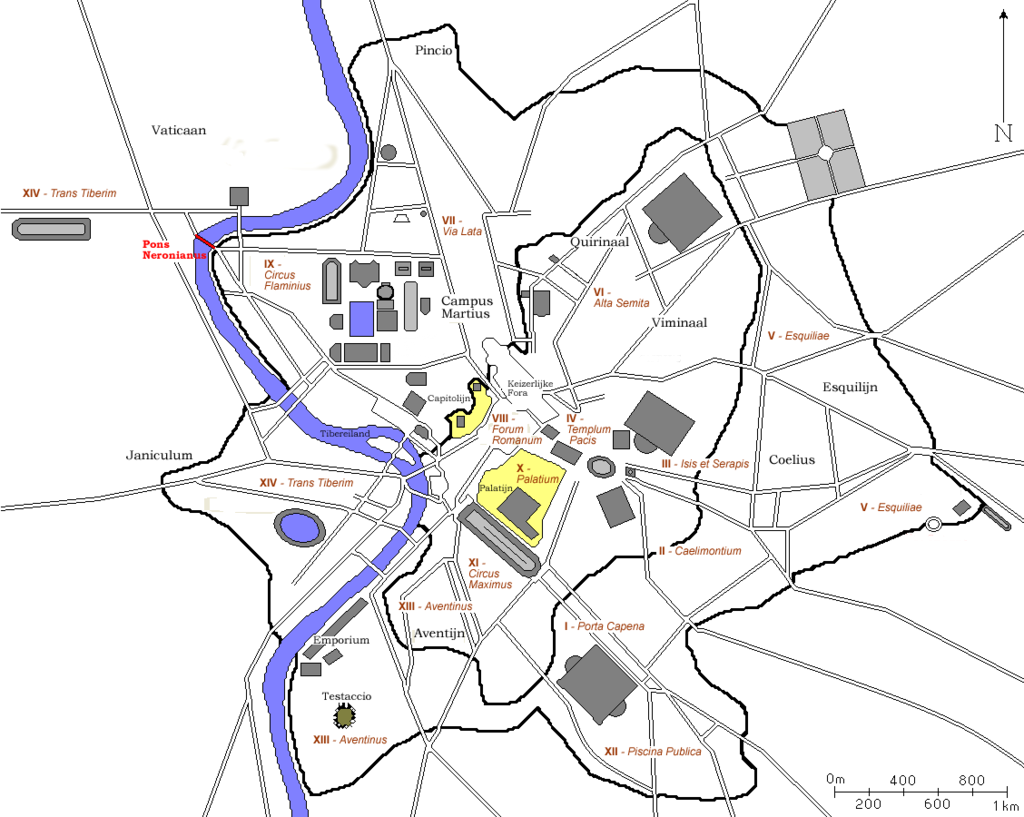Roma
- World of Darkness -- Pax Romana ~SPQR~ Italia ~SPQR~ Quincunx
Quote
Appearance
Climate
Rome has a Mediterranean climate, with cool, humid winters and warm, dry summers.
Its average annual temperature is above (68 °F) during the day and (50 °F) at night. In the coldest month – January, the average temperature is (54 °F) during the day and (37 °F) at night. In the warmest months – July and August, the average temperature is (86 °F) during the day and (64 °F) at night.
December, January and February are the coldest months, with a daily mean temperature of (46 °F). Temperatures during these months generally vary between (50 and 59 °F) during the day and between (37 and 41 °F) at night, with colder or warmer spells occurring frequently. Snowfall is rare but not unheard of, with light snow or flurries occurring almost every winter, generally without accumulation, and major snowfalls approximately once every 5 years.
The average relative humidity is 75%, varying from 72% in July to 77% in November. Sea temperatures vary from a low of (55 °F) in February and March to a high of (75 °F) in August
Economy
[[]]
Geography
Rome is in the Lazio region of central Italy on the Tiber (Italian: Tevere) river. The original settlement developed on hills that faced onto a ford beside the Tiber Island, the only natural ford of the river in this area. The Rome of the Kings was built on seven hills: the Aventine Hill, the Caelian Hill, the Capitoline Hill, the Esquiline Hill, the Palatine Hill, the Quirinal Hill, and the Viminal Hill. Modern Rome is also crossed by another river, the Aniene, which flows into the Tiber north of the historic centre.
Although the city centre is about 24 kilometres (15 mi) inland from the Tyrrhenian Sea, the city territory extends to the shore, where the south-western district of Ostia is located.
Throughout the history of Rome, the urban limits of the city were considered to be the area within the city’s walls. Originally, these consisted of the Servian Wall, which was built twelve years after the Gaulish sack of the city in 390 BC. This contained most of the Esquiline and Caelian hills, as well as the whole of the other five. Rome outgrew the Servian Wall, but no more walls were constructed until almost 700 years later, when, in 270 AD, Emperor Aurelian began building the Aurelian Walls. These were almost 19 kilometres (12 mi) long, and were still the walls the troops of the Kingdom of Italy had to breach to enter the city in 1870.
History
Timeline
Republic
- 499 BC - A battle against foreign tribes commences, including the construction of the Temple of Castor and Pollux.
- 396 BC - The Etruscan city of Veio is defeated by the Romans
- 390 BC - Rome is sacked by the Gauls after the Battle of the Allia.
- 380 BC - The once destroyed Servian Wall is reconstructed.
- 312 BC - The Via Appia and Aqua Appia are constructed.
- 264 - 241 BC - First Punic War
- 220 BC - Via Flaminia is constructed.
- 218 - 202 BC - Second Punic War
- 168 BC - The Romans have a great victory in the Macedonian War, conquering Greece.
- 149 - 146 BC - The Third Punic War
- 133 BC - 120 BC - The Gracchi brothers are controversially killed.
- 71 BC - Spartacus is killed and his rebel army destroyed.
- 60 BC - Pompey, Crassus and Julius Caesar form the first triumvirate.
- 59 BC - Handwritten "news posters" introduced.
- 55 BC - Theatre of Pompey completed.
Imperial Capital
- 49 BC - Caesar crosses the Rubicon in order to take Rome.
- 44 BC - Caesar elects himself dictator, and in March is killed by Brutus and Gaius Cassius Longinus
- 27 BC - Augustus is made Rome's first emperor.
- 13 BC - The Senate commissions the Ara Pacis to honor Augustus' return to Rome.
- c. 60 AD - Paul the Apostle arrives in Rome.
- 64 AD - The Great Fire of Rome, rumored to be blamed by Nero on the Christians.
- c. 65 AD - Blamed for causing the Great Fire, Christians in the city are persecuted.
- 72 AD - Work on the Flavian Amphitheatre (Colosseum) begins.
- 80 AD - While Titus is inspecting the damage of the eruption of Vesuvius, a fire breaks out in the city for three days, destroying Capitoline temples and the Pantheon of Rome.
- 125 AD - Emperor Hadrian has the Pantheon reconstructed, assuming its current appearance.
- 212 AD - All the inhabitants of the empire are granted the citizenship of Rome.
- 216 AD - Work on the Baths of Caracalla is completed.
- 217 AD - Fire, possibly caused by a lightning strike, damages the Flavian Amphitheatre.
- 225 AD - Mathematicians allowed to teach publicly at Rome.
- 247 AD - The first millennium of Rome is celebrated.
- 270 AD - Construction of the Aurelian Wall begins.
- 274 AD - The Temple of the Sun is built at Rome.
- 284 AD - Diocletian partitions administration of the Roman Empire in half, thereby establishing the Eastern Roman Empire in Byzantium.
The Principate
The Restoration of the Republic
By the end of the Republic, the city of Rome had achieved a grandeur befitting the capital of an empire dominating the whole of the Mediterranean.
It was, at the time, the largest city in the world. Estimates of its peak population range from 450,000 to over 3.5 million people with estimates of
1 to 2 million being most popular with historians. This grandeur increased under Augustus, who completed Caesar's projects and added many of his own,
such as the Forum of Augustus and the Ara Pacis. He is said to have remarked that he found Rome a city of brick and left it a city of marble
("Urbem latericium invenit, marmoream reliquit"). Augustus's successors sought to emulate his success in part by adding their own contributions to the city.
Current Events
Politics
History
Population
- 762 A.U.C. - Annual Census: 2,487,669
Citizens of Rome
- ~ Pax Romana Prototype --
https://historica.fandom.com/wiki/Historica
Imperial Household
- ~ Gaius Octavius -- Princeps Civitatis ("First Citizen of the State") - 72yrs old {Deceased}
- ~ Livia Drusilla -- Title (Augusta) - 67yrs old
- ~ Tiberius Julius Caesar -- Son of Livia Drusilla and Tiberius Claudius Nero, he is Augustus son by adoption and heir to the Empire. - 51yrs old
- ~ Vipsania Agrippina -- First wife of Tiberius, who was forced to divorce her husband so he could legally marry Julia the Elder, but remained Tiberius' only love.
- ~ Germanicus Julius Caesar -- Pollux - son of Nero Claudius Drusus and Antonia Minor and adopted by Tiberius - 24yrs old - {A potential victim of a plot to subvert the Principate.}
- ~ Drusus Julius Caesar -- Castor - the son of Emperor Tiberius and Vipsania Agrippina and heir to Tiberius - 23yrs old
- ~ Livilla -- Only daughter of Nero Claudius Drusus and Antonia Minor, sister of Claudius and Germanicus, and wife of Drusus Caesar. - 22yrs old
- ~ Tiberius Julius Caesar -- Son of Livia Drusilla and Tiberius Claudius Nero, he is Augustus son by adoption and heir to the Empire. - 51yrs old
- ~ Marcus Vipsanius Agrippa -- A famous general, husband of Julia the Elder, and a close friend and heir of Augustus {Deceased}
- ~ Julia the Elder -- Daughter of Augustus, wife of Tiberius (separated) and mother of Gaius Caesar, Julia the Younger, Lucius Caesar, Agrippina the Elder, Agrippa Postumus, and Tiberillus - {Exiled} - 48yrs old
- ~ Gaius Caesar -- Eldest grandson and heir to Augustus {Deceased in AD.4}
- ~ Lucius Caesar -- Second grandson and heir to Augustus {Deceased in AD.2}
- ~ Julia the Younger -- was the elder granddaughter of the Emperor Augustus - 28yrs old
- ~ Agrippina the Elder -- The younger granddaughter of the Emperor Augustus and wife of Germanicus - 23yrs old
- ~ Agrippa Postumus -- Youngest surviving male heir and grandson of the Emperor Augustus {Exiled} - 21yrs old
- ~ The Hidden Emperor -- The latest in a long line of Roman urban myths
Numerus Batavorum
The numerus Batavorum, also called the cohors Germanorum, Germani corporis custodes, Germani corpore custodes, Imperial German Bodyguard or Germanic bodyguard was a personal, imperial guards unit for the Roman emperors of the Julio-Claudian dynasty (30 BC – AD 68) composed of Germanic soldiers. Although the Praetorians may be considered the Roman Emperor's main bodyguard, the Germanic bodyguards were a unit of more personal guards recruited from distant parts of the Empire, so they had no political or personal connections with Rome or the provinces.
From De Bello Gallico, it is known that Julius Caesar also had a Germanic bodyguard.
Background
The members of the Numerus Batavorum were recruited from the Germanic tribes resident in, or on the borders of, the Roman province of Germania Inferior, with most recruits drawn from the Batavi but also from neighboring tribes of the Rhine delta region, including the Frisii, Baetasii and Ubii. Little is known about their organization; the 500 bodyguards were formed up in five centuries, each century commanded by a centurion. From inscriptions it is known that there existed, as in all Roman cavalry units, the officer rank of decurion. The exact size of the unit, which was at least partially mounted, is also unknown, but is described in ancient sources as a cohort, which in this period normally implied a strength of c. 500 men, or less precisely as a numerus, whose size could vary. Under the Emperor Caligula, the Bodyguard may have consisted of 500 to 1,000 men.
The Germanic Cohort was valued as loyal and reliable. Emperors like Nero trusted the Germani especially because they were not of Roman origin.
The guard was disbanded briefly after the Battle of the Teutoburg Forest, and was finally dissolved by Galba in 68 because of its loyalty to Nero (ruled 54-68), whom he had overthrown. The decision caused deep offense to the Batavi, and contributed to the outbreak of the Revolt of the Batavi in the following year. Their indirect successors were the Equites singulares Augusti which were, likewise, mainly recruited from the Germani. They were apparently so similar to the Julio-Claudians' earlier Germanic Bodyguard that they were given the same nickname, the "Batavi".
The Roman client king of Judea Herod the Great had a Germanic bodyguard modeled upon that of Augustus.
Praetorian Guard
- ~ Lucius Seius Strabo -- Prefect of the Praetorian Guard
- ~ Sejanus -- Lucius Aelius Sejanus (3 June 20 BC-18 October 31 AD) was Prefect of the Praetorian Guard from 14 to 31 AD.
- He was the right-hand man of Emperor Tiberius for the majority of his reign, and he was used by Tiberius to consolidate his hold
- on power by murdering his political enemies, including his own son, Drusus Julius Caesar. He was arrested and executed in 31 AD
- after being accused of conspiring against Tiberius. {Currently Missing}
Imperial Servants
- ~ Antonius Musa -- Imperial Physician
Senators
- ~ Gaius Asinius Gallus Saloninus -- the son of Gaius Asinius Pollio, consul in 40 BC, and Quinctia. He is best known as the second husband of Vipsania, eldest daughter of Marcus Vipsanius Agrippa and first wife of Tiberius, who will ultimately imprisoned him.
- ~ Vipsania Agrippina -- Wife of Senator Saloninus and mother of Drusus Julius Caesar
- ~ Avitus -- '
- ~ Iunius -- Grandson of Marcus Junius Brutus
- ~ [[]] -- '
- ~ [[]] -- '
Patricians (aristocrats)
- ~ Diadumenus -- Owner of the Amphitheater of Statilius Taurus
- ~ [[]] -- '
- ~ [[]] -- '
- ~ [[]] -- '
- ~ [[]] -- '
Clergy
- ~ Albina Tertius -- High Priestess of Juno
- ~ Aulus Diadumenus -- High Priest of Jupiter
- ~ Longina Septimus -- High Priestess of Minerva
- ~ Lucius Prisca -- High Priest of Venus
- ~ Marcus Festus -- High Priest of Mars
- ~ Tullus Valentinus -- High Priest of Vulcan
- ~ Appius Rufinus -- High Priest of Mercury
- ~ Caius Tertius -- Cultist of Meditrina
- ~ Servius Varius -- Cultist of Phobetor
- ~ Laurentina -- High Priestess of Pluto
- ~ Tertius -- Priest of Pluto
Equites Equestrians
- ~ Antonius Lucius + Junia -- Political Dud *
- ~ [[]] -- '
- ~ [[]] -- '
- ~ [[]] -- '
Merchants
- ~ Porcius + Hortensia -- Merchants of Flesh *
- ~ Claudius Sextilius Marcellus -- Deceased Merchant and Former husband to Caelina
- ~ Caelina Marcellus -- Recent Widow and Friend of Cercyon
- ~ Florianus -- Charioteer and Wagoner
- ~ Appius Cassianus -- Truffle Merchant
- ~ Fulvius Tullius -- Young Iron merchant
Actors
Playwrights
- ~ Gaius Maecenas Melissus -- A popular playwright commonly called Melissus, he specialized in comedies that featured the equestrian class.
Collegia (Roman Guilds)
A collegium (plural collegia), or college, was any association in ancient Rome that
acted as a legal entity. Following the passage of the Lex Julia during the reign of Julius Caesar
as Consul and Dictator of the Roman Republic (49–44 BC), and their reaffirmation during the reign of
Caesar Augustus as Princeps senatus and Imperator of the Roman Army (27 BC–14 AD), collegia
required the approval of the Roman Senate or the Emperor in order to be authorized as legal bodies.
Such associations could be civil or religious. The word collegium literally means "society", from
collega (‘colleague’). They functioned as social clubs or religious collectives whose members worked
towards their shared interests. These shared interests encompassed a wide range of the various aspects of
urban life; including political interests, cult practices, professions, trade, and civic services. The
social connections fostered by collegia contributed to their influence on politics and the economy;
acting as lobbying groups and representative groups for traders and merchants. Some collegia were
linked to participating in political violence and social unrest, which resulted in the suppression of
social associations by the Roman government.
Significant Colligia
- ~ Collegium Armariorum -- Gladiators
- ~ Collegium Bacchus -- Bacchus Worship (Outlawed)
- ~ Collegium Centonariorum -- Junk Men
- ~ Collegium Communionis Minirum -- Actors
- ~ Collegium Lupanariorum -- Brothel Keepers
- ~ Collegium Pistorum -- Bakers
- ~ Collegium Pontificum -- Priests of the state religion
- ~ Collegium Sutorum -- Shoe Makers
- ~ Collegium Vinariorum -- Wine Dealers
Leadership
- Tertius -- Magister of Bakers
Craftsmen
- ~ Salvius -- Architect
- ~ [[]] -- '
- ~ [[]] -- '
- ~ [[]] -- '
- ~ [[]] -- '
Gladiators
- ~ Ercanbald -- Master Gladiator
- ~ [[]] -- '
- ~ [[]] -- '
- ~ [[]] -- '
- ~ [[]] -- '
Plebs (commoners)
- ~ Sabinus -- Legit Nuntium (Public Speaker - News Anouncer) *
- ~ Lucilia -- Upcoming Whore *
- ~ Lucius -- Father of Faustina
- ~ Faustina -- Daughter of Lucius
- ~ Martinus Gnaeus -- Vigiles Urbani (Watchman of the City)
- ~ Circle of Hungry Dreamers -- A circle of starving roman homeless. {30+}
- ~ Saturninus -- Firebug
Servants
- ~ [[]] -- '
- ~ [[]] -- '
- ~ [[]] -- '
- ~ [[]] -- '
- ~ [[]] -- '
Slaves
- ~ Valerius the Young -- Palace Herald
- ~ Gratiana -- Slave of Goda
- ~ [[]] -- '
- ~ [[]] -- '
- ~ [[]] -- '
Criminals
- ~ Ayanda -- Leader of the Aetius Convocation
- ~ Avilius -- Albino Thief *
- ~ Naevius -- Roman Fagin
- ~ Tatiana -- Little Girl
- ~ [[]] -- '
Expatriates
- ~ Publius Ovidius Naso -- AKA: Ovid (Roman Poet)
Eateries
Popina
Taberna
Thermopolium
Festivities
October
- 11: Meditrinalia -- A celebration commemorating wine where the old vintage and new vintage are mixed with the blessings of the goddess - Meditrina (goddess of health, longevity and wine).
- 12: Augustalia, celebrated from 14 AD in honor of the divinized Augustus, established in 19 BC with a new altar and sacrifice to Fortuna Redux
- 13: Fontinalia in honour of Fons (god of divine and purified waters)
- 14: ceremonies to mark a restoration of the Temple of the Penates Dei on the Velian Hill
- 15 (Ides): October Horse sacrifice to Mars in the Campus Martius; also Feriae of Jupiter
- 16: Lupinalia, the Festival of Wolves
- 19: Armilustrium, a dies religious in honor of Mars
Fortifications
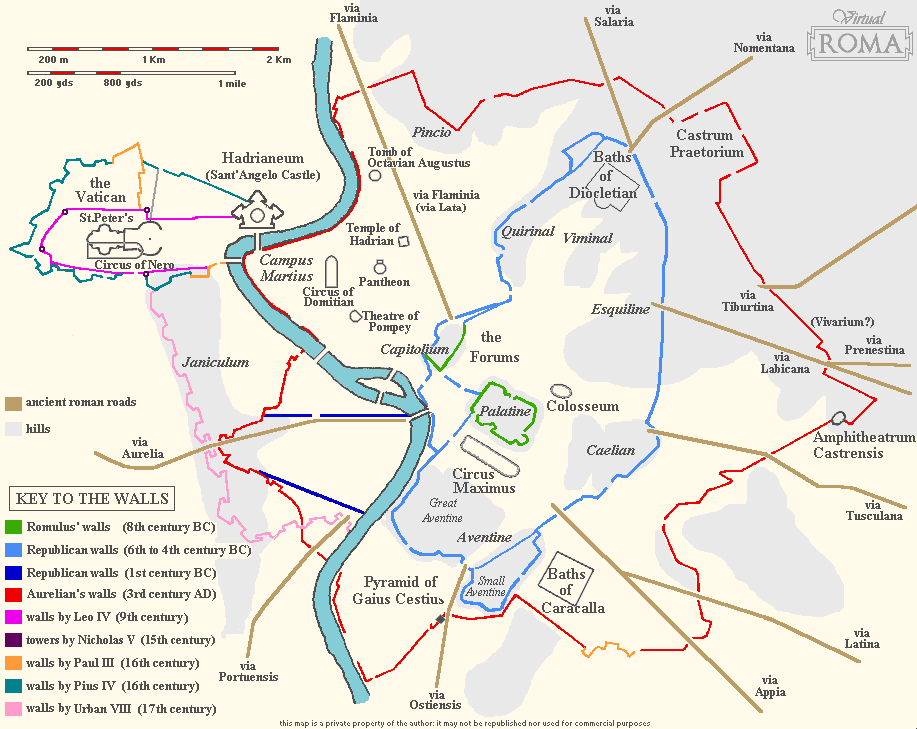
Defensive walls are a feature of ancient Roman architecture. The Romans generally fortified cities, rather than fortresses, but there are some fortified camps, such as the Saxon Shore forts like Porchester Castle in England. City walls were already significant in Etruscan architecture, and in the struggle for control of Italy under the early Republic many more were built, using different techniques. These included tightly-fitting massive irregular polygonal blocks, shaped to fit exactly in a way reminiscent of later Inca work. The Romans called a simple rampart wall an agger; at this date great height was not necessary.
Servian Wall
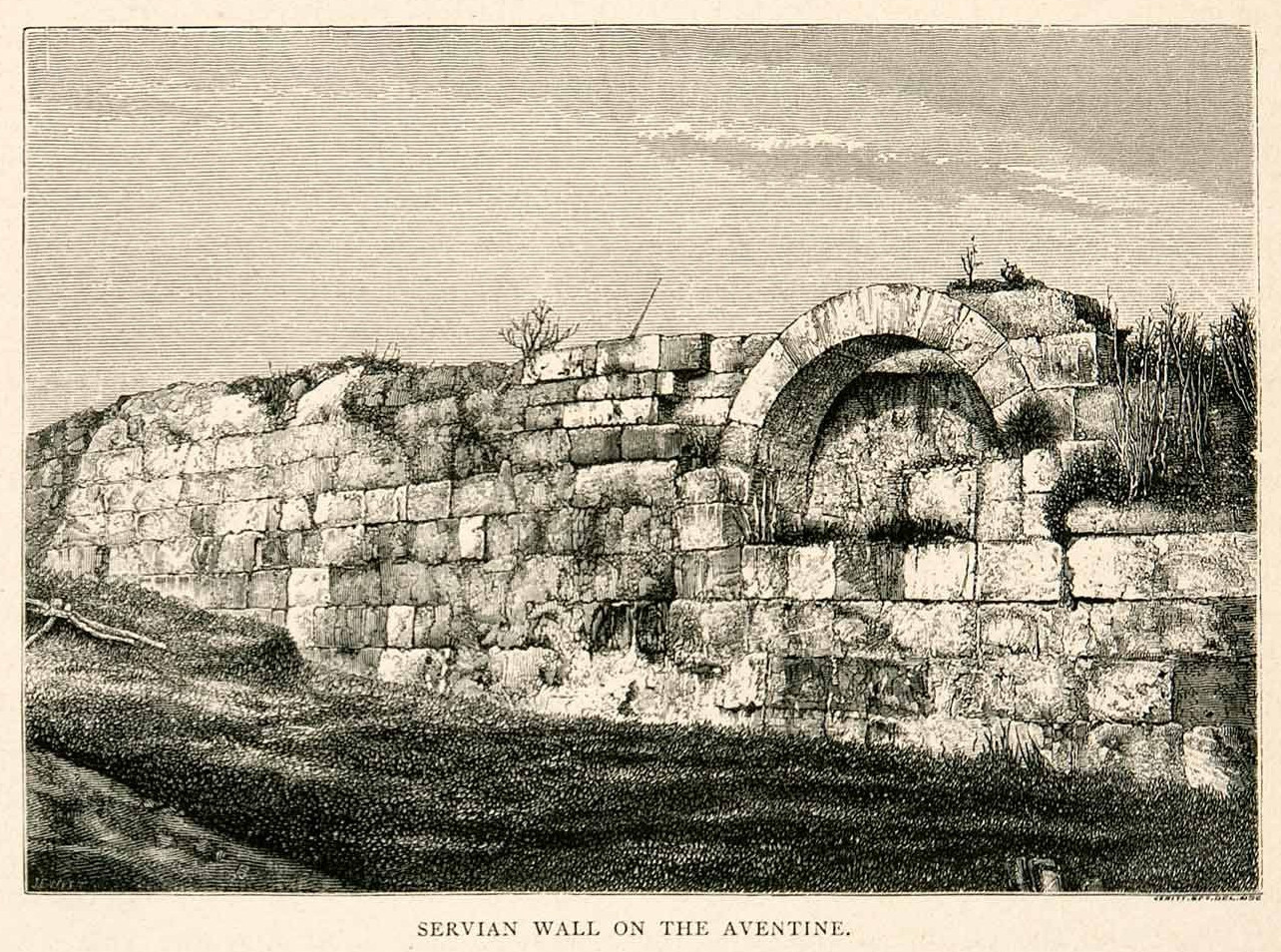
The Servian Wall (outlined in blue) was an ancient Roman defensive barrier constructed around the city of Rome in the early 4th century BC. The wall was up to 10 metres (32.8 ft) in height in places, 3.6 metres (12 ft) wide at its base, 11 km (7 mi) long,[1] and is believed to have had 16 main gates, though many of these are mentioned only from writings, with no other known remains. By the 3rd century AD it was superseded by the construction of the larger Aurelian Walls.
History
It is presumed that the wall is named after the sixth Roman King, Servius Tullius. Although its outline may go back to the 6th century BC, the currently extant wall was, it is estimated, built during the early Roman Republic, possibly as a way to prevent a repeat of the sack of Rome after the Battle of the Allia by the Gauls of Brennus. Due to the ease with which the Gauls entered the city, it is conjectured[by whom?] that at some time previous to this, Rome had been forced by its Etruscan rulers to dismantle any significant prior defenses.
Construction
The wall was built from large blocks of tuff (a volcanic rock made from ash and rock fragments ejected during an eruption) quarried from the Grotta Oscura quarry near Rome's early rival Veii. In addition to the blocks, some sections of the structure incorporated a deep fossa, or ditch in front of it, as a means to effectively heighten the wall during attack from invaders.
Along part of its topographically weaker northern perimeter was an agger, a defensive ramp of earth heaped up to the wall along the inside. This thickened the wall, and also gave defenders a base to stand while repelling any attack. The wall was also outfitted with defensive war engines, including catapults.
Usage
The Servian Wall was formidable enough to repel Hannibal during the Second Punic War. Hannibal famously invaded Italy across the Alps with elephants, and had crushed several Roman armies in the early stages of the war. However, the wall was never put to the test as Hannibal only once, in 211 BC, brought his Carthaginian army to Rome as part of a feint to draw the Roman army from Capua. When it was clear that this had failed, he turned away, without approaching closer than 3 miles (5 km) to Rome, as a Roman army sallied out of the Servian walls and pitched a camp next to Hannibal's. During the Roman civil wars, the Servian walls were repeatedly overrun.
The wall was still maintained through the end of the Republic and in the early Empire. By this time, Rome had already begun to grow outside the original Servian Wall. The organization of Rome into regions under Augustus placed regions II, III, IV, VI, VIII, X, and XI within the Servian Wall, with the other sections outside of it.[citation needed]
The wall became unnecessary as Rome became well protected by the ever-expanding military strength of the Republic and of the later Empire. As the city continued to grow and prosper, it was essentially unwalled for the first three centuries of the Empire.
Gates
List of gates (porte), from the northernmost and clockwise:
• Porta Flaminia – here begins via Flaminia
• Porta Pinciana
• Porta Salaria – here begins via Salaria
• Porta Pia – here begins the new via Nomentana
• Porta Nomentana – here began the old via Nomentana
• Porta Praetoriana – entrance to Castra Praetoria, the camp of the Praetorian Guard
• Porta Tiburtina – here begins via Tiburtina
• Porta Praenestina) – here three aqueducts meet, and via Praenestina begins
• Porta Asinaria – here begins the old via Tuscolana
• Porta Metronia
• Porta Latina – here begins via Latina
• Porta Appia – here begins the Appian Way
• Porta Ardeatina
• Porta Ostiense – next to the Pyramid of Cestius, leading to Basilica di San Paolo fuori le Mura, here via Ostiense begins
Law & Lawlessness
Police Forces
- ~ Cohortes Urbanae -- Police Forces (daytime)
- ~ Cohortes Praetoriae -- Praetorian Guard (Roman Imperial agency of Intelligence & Security)
- ~ Vigiles -- Nightwatchmen (nocturnal police) & Firefighters
Lodging
Cauponae (Public Accommodations)
Hospitia (Private Establishments)
https://www.quora.com/Were-there-hotels-and-restaurants-in-Ancient-Rome?share=1
https://penelope.uchicago.edu/Thayer/E/Roman/Texts/secondary/SMIGRA*/Caupona.html
https://penelope.uchicago.edu/Thayer/E/Roman/Texts/secondary/SMIGRA*/Hospitium.html
Monuments
See: List of ancient monuments in Rome -- Wikipedia (https://en.wikipedia.org/wiki/List_of_ancient_monuments_in_Rome)
Arches (Triumphal)
- Arcus Argentariorum
- Arcus Novus
- Arch of Augustus
- Arch of Dolabella and Silanus
- Arch of Drusus
- Arch of Janus
- Arch of Lentulus and Crispinus
- Arch of Octavius
- Arch of Pietas
- Arch of Titus (Circus Maximus)
- Arch of Titus (Roman Forum)
Aqueducts
- Anio Novus
- Anio Vetus
- Aqua Alexandriana
- Aqua Alsietina
- Aqua Appia
- Aqua Augusta (Rome)|Aqua Augusta
- Aqua Claudia
- Aqua Julia
- Aqua Marcia
- Aqua Martia
- Aqua Tepula
- Aqua Traiana
- Aqua Virgo
Amphitheaters
- ~ Amphitheater of Statilius Taurus -- An amphitheater inaugurated in 29 BC.
- ~ Arenam Deorum --
Ludus of Rome
Gladiator School
"He vows to endure to be burned, to be bound, to be beaten, and to be killed by the sword." -- The gladiator's oath as cited by Petronius (Satyricon, 117).
The earliest named gladiator school (singular: ludus; plural: ludi) is that of Aurelius Scaurus at Capua. He was lanista of the gladiators employed
by the state circa 105 BC to instruct the legions and simultaneously entertain the public. Few other lanistae are known by name: they headed their
familia gladiatoria, and had lawful power over life and death of every family member, including servi poenae, auctorati and ancillaries. Socially,
they were infames, on a footing with pimps and butchers and despised as price gougers. No such stigma was attached to a gladiator owner (munerarius or editor)
of good family, high status and independent means; Cicero congratulated his friend Atticus on buying a splendid troop – if he rented them out, he might recover
their entire cost after two performances.
The Spartacus revolt had originated in a gladiator school privately owned by Lentulus Batiatus, and had been suppressed only after a protracted series of costly,
sometimes disastrous campaigns by regular Roman troops. In the late Republican era, a fear of similar uprisings, the usefulness of gladiator schools in creating private
armies, and the exploitation of munera for political gain led to increased restrictions on gladiator school ownership, siting and organization. By Domitian's time,
many had been more or less absorbed by the State, including those at Pergamum, Alexandria, Praeneste and Capua. The city of Rome itself had four; the Ludus Magnus
(the largest and most important, housing up to about 2,000 gladiators), Ludus Dacicus, Ludus Gallicus, and the Ludus Matutinus, which trained bestiarii.
In the Imperial era, volunteers required a magistrate's permission to join a school as auctorati. If this was granted, the school's physician assessed their suitability.
Their contract (auctoramentum) stipulated how often they were to perform, their fighting style and earnings. A condemned bankrupt or debtor accepted as novice (novicius)
could negotiate with his lanista or editor for the partial or complete payment of his debt. Faced with runaway re-enlistment fees for skilled auctorati, Marcus Aurelius
set their upper limit at 12,000 sesterces.
All prospective gladiators, whether volunteer or condemned, were bound to service by a sacred oath (sacramentum). Novices (novicii) trained under teachers of particular
fighting styles, probably retired gladiators. They could ascend through a hierarchy of grades (singular: palus) in which primus palus was the highest. Lethal weapons
were prohibited in the schools – weighted, blunt wooden versions were probably used. Fighting styles were probably learned through constant rehearsal as choreographed "numbers".
An elegant, economical style was preferred. Training included preparation for a stoical, unflinching death. Successful training required intense commitment.
Those condemned ad ludum were probably branded or marked with a tattoo (stigma, plural stigmata) on the face, legs and/or hands. These stigmata may have been text
– slaves were sometimes thus marked on the forehead until Constantine banned the use of facial stigmata in 325 AD. Soldiers were routinely marked on the hand.
Gladiators were typically accommodated in cells, arranged in barrack formation around a central practice arena. Juvenal describes the segregation of gladiators according to
type and status, suggestive of rigid hierarchies within the schools: "even the lowest scum of the arena observe this rule; even in prison they're separate". Retiarii
were kept away from damnati, and "fag targeteers" from "armoured heavies". As most ordinarii at games were from the same school, this kept potential opponents
separate and safe from each other until the lawful munus. Discipline could be extreme, even lethal. Remains of a Pompeian ludus site attest to developments in supply,
demand and discipline; in its earliest phase, the building could accommodate 15–20 gladiators. Its replacement could have housed about 100 and included a very small cell,
probably for lesser punishments and so low that standing was impossible.
Care & Feeding
Despite the harsh discipline, gladiators represented a substantial investment for their lanista and were otherwise well fed and cared for. Their daily, high-energy, vegetarian
diet consisted of barley, boiled beans, oatmeal, ash and dried fruit. Gladiators were sometimes called hordearii (eaters of barley). Romans considered barley inferior to wheat
— a punishment for legionaries replaced their wheat ration with it — but it was thought to strengthen the body. Regular massage and high quality medical care helped mitigate an
otherwise very severe training regimen. Part of Galen's medical training was at a gladiator school in Pergamum where he saw (and would later criticize) the training, diet, and
long-term health prospects of the gladiators.
Future Schools within Rome
In 9AD there are no gladiatorial schools in Rome.
- ~ Ludus Magnus -- The largest and most important gladiatorial school which housed up to about 2,000 gladiators. (r. 81–96 C.E.)
- ~ Ludus Dacicus -- (r. 81 - 96 AD)
- ~ Ludus Gallicus
- ~ Ludus Matutinus -- Which specialized in training gladiators who fight wild animals (bestiarii).
Baths
- Baths of Agrippa -- Rome's first public bath.
Bridges
- Pons Aemilius
- Pons Cestius
- Pons Fabricius
- Pons Milvius
- Pons Probi
- Pons Sublicius
Brothels (Lupanaria)
Catacombs
Rome has a extensive number of ancient catacombs, or underground burial places beneath or near the city, of which there are at least forty. Though most famous for Christian burials, they include pagan and Jewish burials, either in separate catacombs or mixed together. The first large-scale catacombs were excavated from the 2nd century onwards, mainly as a response to overcrowding and shortage of land. Originally they were carved through tuff, a soft volcanic rock, outside the boundaries of the city, because Roman law forbade burial places within city limits.
Those Who Came Before
The Etruscans, like many other European people, used to bury their dead in underground chambers. The original Roman custom was cremation, after which the burnt remains were kept in a pot, ash-chest or urn, often in a columbarium. From about the 2nd century AD, inhumation (burial of unburnt remains) became more fashionable, in graves or sarcophagi, often elaborately carved, for those who could afford them. Christians also preferred burial to cremation because of their belief in bodily resurrection at the Second Coming.
Jews and Christians
Since most Christians and Jews at that time belonged to the lower classes or were slaves, they usually lacked the resources to buy land for burial purposes. Instead, networks of tunnels were dug in the deep layers of tuff which occurred naturally on the outskirts of Rome. At first, these tunnels were probably not used for regular worship, but simply for burial and, extending pre-existing Roman customs, for memorial services and celebrations of the anniversaries of Christian martyrs. There are sixty known subterranean burial chambers in Rome. They were built outside the walls along main Roman roads, like the Via Appia, the Via Ostiense, the Via Labicana, the Via Tiburtina, and the Via Nomentana. Names of the catacombs – like St Calixtus and St Sebastian, which is alongside Via Appia – refer to martyrs that may have been buried there. About 80% of the excavations used for Christian burials date to after the time of the persecutions.
Construction
Roman catacombs are made up of underground passages (ambulacra), out of whose walls graves (loculi) were dug. These loculi, generally laid out vertically (pilae), could contain one or more bodies. A loculus large enough to contain two bodies was referred to as a bisomus. Another type of burial, typical of Roman catacombs, was the arcosolium, consisting of a curved niche, enclosed under a carved horizontal marble slab. Cubicula (burial rooms containing loculi all for one family) and cryptae (chapels decorated with frescoes) are also commonly found in catacomb passages. When space began to run out, other graves were also dug in the floor of the corridors - these graves are called formae.
Excavators (fossors), built vast systems of galleries and passages on top of each other. They lie 7–19 metres (23–62 ft) below the surface in an area of more than 2.4 square kilometres (590 acres). Narrow steps that descend as many as four stories join the levels. Passages are about 2.5 by 1 metre (8.2 ft × 3.3 ft). Burial niches (loculi) were carved into walls. They are 40–60 centimetres (16–24 in) high and 120–150 centimetres (47–59 in) long. Bodies were placed in chambers in stone sarcophagi in their clothes and bound in linen. Then the chamber was sealed with a slab bearing the name, age and the day of death. The fresco decorations provide the main surviving evidence for Early Christian art, and initially show typically Roman styles used for decorating homes - with secular iconography adapted to a religious function. The catacomb of Saint Agnes is a small church. Some families were able to construct cubicula which would house various loculi and the architectural elements of the space would offer a support for decoration. Another excellent place for artistic programs were the arcosolia.
The Catacombs of Rome
The Roman catacombs, of which there are forty in the suburbs, were built along the consular roads out of Rome, such as the Appian way, the via Ostiense, the via Labicana, the via Tiburtina, and the via Nomentana.
- Jewish Catacombs -- There are six known Jewish catacombs in Rome, two of which are open to the public: Vigna Randanini and Villa Torlonia.
Cemeteries
- Columbarium of Pomponius Hylas -- is a 1st-century AD Roman columbarium, situated near the Porta Latina on the Via Appia. Columbarium
- Esquiline Necropolis -- The Esquiline Necropolis was a prehistoric necropolis on the Esquiline in Rome, in use until the end of the 1st century AD.
- Vatican Necropolis -- The Vatican Necropolis lies on the upper slopes of Vatican Hill.
Mausolea
Tombs
Circuses
- Circus Flaminius
- Circus Maximus
Columns
Fora
https://en.wikipedia.org/wiki/Roman_Forum
Fountains
Gardens
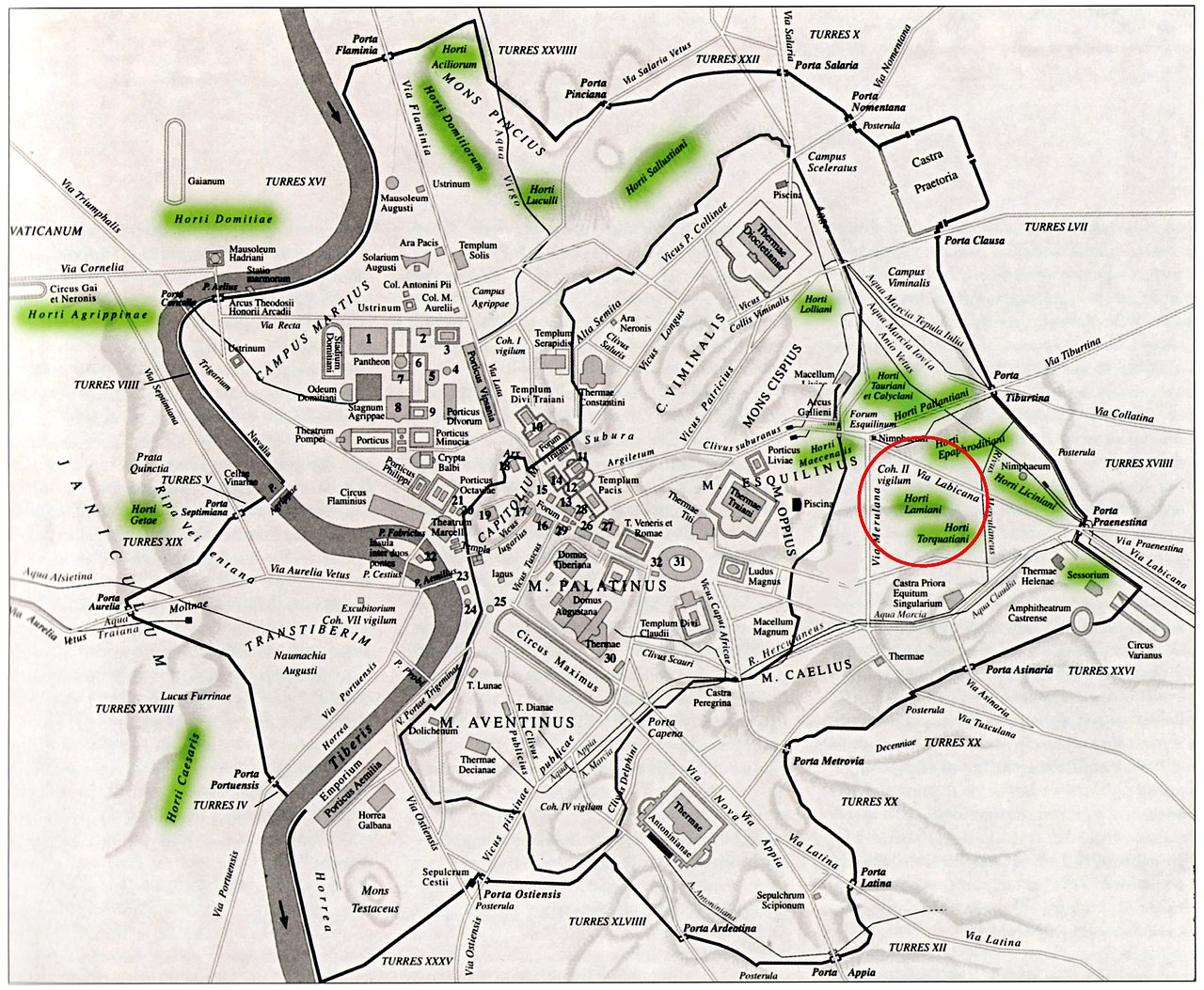
https://en.wikipedia.org/wiki/List_of_parks_and_gardens_in_Rome
Gardens of Sallust
https://en.wikipedia.org/wiki/Gardens_of_Sallust
Infamous Locales
Libraries
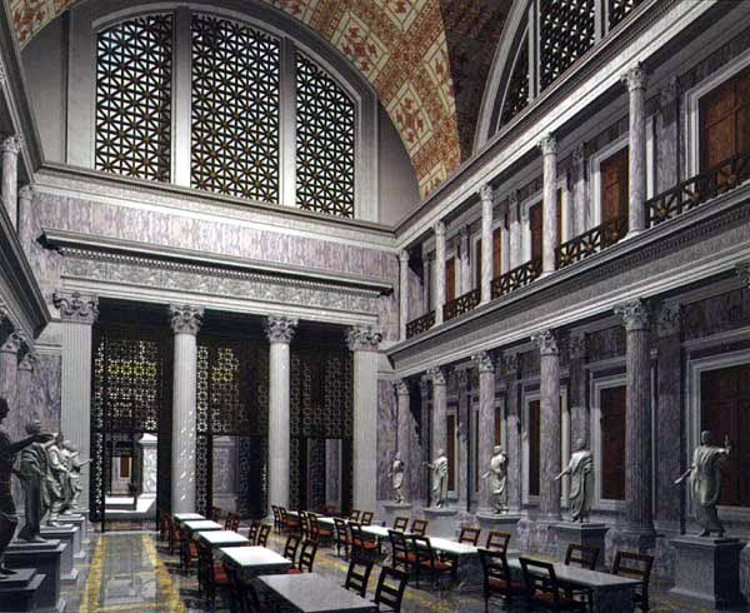
The first public library in Rome was finally founded by Asinius Pollio. From the spoils of the war he constructed and erected the library
in the Atrium Libertatis, which he adorned with statues of the most celebrated heroes as well as other famous works of art all open to the
public. The library had Greek and Latin wings, and reportedly its establishment posthumously fulfilled one of Caesar's ambitions. Pollio
retired into private life as a patron of literary figures and became a writer. He was known as a severe literary critic, fond of an archaic
style and purity.
In retirement, Pollio organized literary readings where he encouraged authors to read their own work, and he was the first Roman author to
recite his own works. One of the most dramatic such readings brought the poet Virgil to the attention of the imperial family, when Virgil
read from his work-in-progress the Aeneid, and flattered the imperial family by his portrayal of Aeneas, whom the Julii Caesares believed
to be their direct patrilineal ancestor. As a result, Virgil was praised by Augustus himself.
The library of Pollio was followed by that of Augustus in the Temple of Apollo on the Palatine Hill, another, the Bibliotheca Octaviana
(so called from Augustus's sister Octavia), forming part of the Porticus Octavia.
- ~ Library of Augustus (Temple of Apollo)
- ~ Bibliotheca Octaviana (Porticus Octavia)
There were also libraries on the Capitol, in the Temple of Peace founded by Vespasian, in the palace of Tiberius, besides the Ulpian Library
(so called after its founder, Trajan), which was the most famous. This library was attached by Diocletian, as an ornament, to his thermae.
Private collections of books were made at Rome soon after the Second Punic War, sometimes from the spoils of Grecian or Eastern conquest.
Thus Aemilius Paulus brought to Rome the library of Perseus, king of Macedonia; Sulla, that of Apellicon of Teos; Lucullus, the extensive
one of the kings of Pontus, to which he gave the public free access.
The zeal of Cicero, Atticus,Varro, and others in increasing their libraries is well known. Scholar Serenus Sammonicus possessed a personal
library of 62,000 books. Towards the end of the Republic it became, in fact, the fashion to have a room elegantly furnished as a library,
and reserved for that purpose. However illiterate a person might be, it was fashionable to appear learned by having a library, though he
might never be able to read any of the books.
Source: https://www.crystalinks.com/romelibrary.html
Ludi (schools)
Ludus (plural ludi) in ancient Rome could refer to a primary school, a board game, or a gladiator training school. The various
meanings of the Latin word are all within the semantic field of "play, game, sport, training" (see also ludic).
An elementary or primary school or the school of the “litterator" attended by boys and girls up to the age of 11 was a ludus. Ludi were
to be found throughout the city, and were run by a ludi magister (schoolmaster) who was often an educated slave or freedman. School
started around six o'clock each morning and finished just after midday. Students were taught math, reading, writing, poetry, geometry and
sometimes rhetoric.
The word ludus also referred to a training school for gladiators; see Gladiator: Schools and training. Examples include the Ludus Magnus
and Ludus Dacicus.
Ludus was also the word for a board game, examples of which include ludus latrunculorum and ludus duodecim scriptorum, or a game played
with knucklebones (astragali).
Latin poetry often explores the concept of ludus as playfulness, both in the writing of poetry as a kind of play and as a field for erotic
role-playing. "Poetic play (ludus, ludere, iocum, etc.)," Michèle Lowrie observes, "denotes two related things: stylistic elegance of the
Alexandrian variety and erotic poetry."
Ludi, always plural, were the games held in conjunction with Roman religious festivals.
Porticoes
- ~ Porticus Octaviae -- The colonnaded walks of the portico enclose the temples of Jupiter Stator and Juno Regina, as well as a library. {Located close to the the Theatre of Marcellus upon the Capitoline Hill}
Shops
Statues
Theaters
- ~ Theatre of Balbus -- It was built in 13 BC by proconsul Lucius Cornelius Balbus (minor), located in the Campus Martius of Rome.
- ~ Theatre of Pompey -- Completed in 55 BC, it was the first permanent theatre to be built in Rome. Its ruins are located at Largo di Torre Argentina.
- ~ Theatre of Marcellus -- is an ancient open-air theatre in Rome, built in the closing years of the Roman Republic. {Capitoline Hill}
https://en.wikipedia.org/wiki/List_of_Roman_theatres
Regiones de Roma
- I: Regio I Porta Capena
- Regio I took its name from the Porta Capena ("Gate to Capua"), a gate through the Servian Walls which the Appian Way takes to get into the city. Beginning from this to the south of the Caelian Hill, it runs to the future track of the Aurelian Walls.
- II: Regio II Caelimontium
- Regio II encompassed the Caelian Hill.
- III: Regio III Isis et Serapis
- Regio III took its name from the sanctuary of Isis, in the area of the modern Labicana street, containing the valley which was to be the future site of the Colosseum, and parts of the Oppian and Esquiline hills.
- IV: Regio IV Templum Pacis
- Regio IV took its name from the Temple of Peace built in the region by Vespasian. It includes the valley between the Esquiline and the Viminal hills, the popular area of the Subura, and the Velian Hill (the hill between the Palatine and the Oppian Hill, removed in the early 20th century to make way for the via dei Fori Imperiali, the street passing between the Forum Romanum and the Forum of Augustus).
- V: Regio V Esquiliae
- The name of Regio V derives from the Esquiline hill. It contains parts of the Oppian and Cispian (two minor hills close to the city center) and of the Esquiline, plus the plain just outside the Servian walls.
- VI: Regio VI Alta Semita
- The name of Regio VI derives from the street (Alta Semita, "High Path") passing over the Quirinal Hill. It was a large regio that encompassed also the Viminal Hill, the lower slopes of the Pincian, and the valleys between these. Its major landmarks included the Baths of Diocletian, the Baths of Constantine, and the Gardens of Sallust; gardens (horti) covered much of its northern part. Temples to Quirinus, Salus, and Flora were also located in Regio VI, and the Castra Praetoria. The Aurelian Wall marked most of its eastern and northern edge, with the Argiletum and Vicus Patricius on the south and southeast.[2]
- VII: Regio VII Via Lata
- The name of Regio VII was derived from the via Flaminia which runs between the Servian walls and the future Aurelian Walls. This was a wide urban street (Via Lata, "Broadway"), corresponding to the modern via del Corso. The regio contained part of the Campus Martius on the east of the street plus the Collis Hortulorum (Hill of the Hortuli), the Pincian Hill (modern Pincio).
- VIII: Regio VIII Forum Romanum
- The central region contains the Capitoline Hill, the valley between the Palatine and the Capitoline hills (where the Forum Romanum is located), and the area between Velian Hill and the Palatine up to the Arch of Titus and the Temple of Venus and Roma.
- IX: Regio IX Circus Flaminius
- The name derives from the racecourse located in the southern end of the Campus Martius, close to Tiber Island. The region contains part of the Campus Martius, on the west side of via Lata.
- X: Regio X Palatium
- The Palatine Hill gave its name to Regio X.
- XI: Regio XI Circus Maximus
- Regio XI took its name from the Circus Maximus, located in the valley between the Palatine and the Aventine. It contained the Circus Maximus, the Velabrum (the valley between the Palatine and Capitoline), as well as the areas next to the Forum Boarium and the Forum Holitorium.
- XII: Regio XII Piscina Publica
- Regio XII took its name from the Piscina Publica, a monument that disappeared during the Empire. It had the high ground where the church of San Saba is at present, plus its ramifications towards the Appian Way, where Caracalla's baths were.
- In the 180s, a bank and exchange for Christians operated in the area.[3]
- XIII: Regio XIII Aventinus
- Regio XIII contained the Aventine Hill and the plain in front of it, along the Tiber. Here was the Emporium, the first port on the river.
- XIV: Regio XIV Transtiberim
- Regio XIV (the region "across the Tiber") contained Tiber Island and all the parts of Rome west beyond the Tiber. This is modern Trastevere.
https://en.wikipedia.org/wiki/14_regions_of_Augustan_Rome
Objects of Mystery
- ~ Amulet of the Mundane
- ~ Armor of Achilles
- ~ Dagger of the Moon
- ~ Glass Knife
- ~ Mask of Proteus
- ~ Mishanter Coin
- ~ Roman Loculus
- ~ Spear of Quietus
- ~ Specie Janus
Private Residences
Spirits
Genius Loci
Taverns
Religion
Collegium Pontificum (Priesthood of the State)
The College of Pontiffs (Latin: Collegium Pontificum) was a body of the ancient Roman state whose members
were the highest-ranking priests of the state religion. The college consisted of the Pontifex Maximus and the
other pontifices, the Rex Sacrorum, the fifteen flamens, and the Vestals. The College of Pontiffs was
one of the four major priestly colleges; originally their responsibility was limited to supervising both public and
private sacrifices, but as time passed their responsibilities increased. The other colleges were the augurs
(who read omens), the quindecimviri sacris faciundis ("fifteen men who carry out the rites"), and the Epulones
(who set up feasts at festivals).
The title pontifex comes from the Latin for "bridge builder", a possible allusion to a very early role in
placating the gods and spirits associated with the Tiber River, for instance. Also, Varro cites this position as
meaning "able to do".
The pontifex maximus was the most important member of the college. Until 104 BC, the pontifex maximus held
the sole power in appointing members to the other priesthoods in the college.
The flamens were priests in charge of fifteen official cults of Roman religion, each assigned to a particular god.
The three major flamens (flamines maiores) were the Flamen Dialis, the high priest of Jupiter; the Flamen Martialis,
who cultivated Mars; and the Flamen Quirinalis, devoted to Quirinus. The deities cultivated by the twelve flamines minores
were Carmenta, Ceres, Falacer, Flora, Furrina, Palatua, Pomona, Portunus, Volcanus (Vulcan), Volturnus, and two whose names are
now lost.
The Vestal Virgins were the only female members of the college. They were in charge of guarding Rome's sacred hearth, keeping
the flame burning inside the Temple of Vesta. Around age 6 to 10, girls were chosen for this position and were required to perform
the rites and obligations for 30 years, including remaining chaste.
Aventine Triad
The Aventine Triad (also referred to as the plebeian Triad or the agricultural Triad) is a modern term for the joint cult of the Roman deities Ceres, Liber and Libera. The cult was established ca. 493 BC within a sacred district (templum) on or near the Aventine Hill, traditionally associated with the Roman plebs. Later accounts describe the temple building and rites as "Greek" in style. Some modern historians describe the Aventine Triad as a plebeian parallel and self-conscious antithesis to the Archaic Triad of Jupiter, Mars and Quirinus and the later Capitoline Triad of Jupiter, Minerva and Juno. The Aventine Triad, temple and associated ludi (games and theatrical performances) served as a focus of plebeian identity, sometimes in opposition to Rome's original ruling elite, the patricians.
Capitoline Triad
The Capitoline Triad was a group of three deities who were worshiped in ancient Roman
religion in an elaborate temple on Rome's Capitoline Hill (Latin Capitolium). It
comprised Jupiter, Juno and Minerva. The triad held a central place in the public religion
of Rome. Although each of the triad has their own temple, they share veneration jointly
within the Temple of Jupiter Optimus Maximus, where each has a personal shrine and
there is also an older temple to the triad upon the Quirinal Hill called the Capitolium Vetus
which is much smaller and essentially a shrine.
Nova Tetrad
- ~ VENUS -- Goddess of Beauty & Love
- ~ MARS -- God of War
- ~ VULCAN -- God of Craft & Industry
- ~ MERCURY -- God of Boundaries and Travel
Demigods
- ~ Carmenta -- Goddess of Childbirth and Prophecy
- ~ Flora -- goddess of flowers and spring
- ~ [[]] -- '
- ~ [[]] -- '
- ~ [[]] -- '
- ~ Mors -- Lady of Death --
- ~ Morpheus -- Lord of Dreams
Divine Mortals & Lesser Gods
- ~ MEDITRINA -- Roman Goddess of Health, Longevity and Wine.
- ~ [[]] -- '
- ~ [[]] -- '
- ~ Pomona -- Wood Nymph of Fruit Trees
- ~ Phobetor -- Lord of Nightmares -- Like the other Oneiroi, followers of Phobetor exist and rumor holds a secret temple has been established in Rome.
- ~ Gaius Julius -- Divine King - {Currently his spirit lies waiting in the Underworld}
Creatures of Rome
- ~ Furrina -- Nymph of Springs
Cults
- ~ Brotherhood of the Knife -- A secret society of assassins
- ~ Circle of Hungry Dreamers -- A group of indigents who worship Morpheus
- ~ Cult of Victoria Nemetona -- Celtic-Romano fusion faith who worship Siobhán
- ~ Daughters of the Earth -- All female worshipers of Mount Vesuvius who seek to renew their god. Extravasate
- ~ Heirs of Hercules -- Scions of various families who claim descent from the hero Hercules
- ~ Invictus -- ????
- ~ Kabeiri -- Mystery Cult of Asia Minor (Blacksmithing & Fire)
- ~ Riders of Doom -- A Roman Centrist cult of Warriors dedicated to Mars
- ~ Servants of Harpocrates -- A cult dedicated to silence, secrets and confidentiality.
- ~ [[]] --
- ~ [[]] --
Alien Deities & Demons
- ~ Cercyon -- Divine Smith -- {Sucellus} <NEMETONDEVOS>
- ~ Siobhán -- Celtic Goddess of Storms & Battles -- {Cathubodua} <CRUACH>
Temples
Rome is home to seventy-two known temples and countless lesser cults that meet in private homes
or have secret shrines where less well known gods are worshiped and a few that have been outlawed
for their alien nature or depravity. An excellent example is the Temple of the Dii Inferi that is
rumored to be hidden somewhere in the city and the Collegia of Bacchus whose orgiastic rites are
considered a threat to the order of the Roman state. Over time alien cults and temples wormed their
way into Roman society including the Cult of Isis and Serapis from Egypt and the Cult of Cybele
from Asia Minor. Perhaps to counter these foreign faiths or out an innately Roman conservatism,
the emperors were deified and become part of a state religion that all pious or patriotic Romans
offered sacrifices to in the name of imperial stability and safety. This uniquely Roman development
brought the worship of deified emperors directly into the homes of common Romans where they previously
only offered worship to specific gods, their familial dead and the spirits that protected the hearth
and home.
Aventine Hill
- Temple of Bona Dea -- Established in the 3rd century BC. The temple was dedicated to fertility, healing and snake-handling.
- Temple of Ceres
- Temple of Diana Aventina
- Temple of Juno Regina
- Temple of Luna
- Temple of Mercury -- Dedicated in 495 BC, this temple is one of the oldest and most revered in Rome.
- Temple of Minerva -- An ancient temple famous for its association with the crafts guilds. See: Collegia
- Temple of Morpheus -- Established in 9AD. The cult has exploded onto the scene following the "Varian Distaster."
Caelian Hill
In 9AD there are no temples of significance upon the Caelian Hill.
Capitoline Hill
- Temple of Fides
- Temple of Jupiter Custos
- Temple of Jupiter Feretrius
- Temple of Jupiter Optimus Maximus -- The most important temple in Rome.
- Temple of Jupiter Tonans
- Temple of Juno Moneta -- Temple of Juno the Protector of Money (near the Roman mint)
- Temple of Ops
- Temple of Veiovis
- Temple of Fortuna Redux
Campus Martius
- Temple of Apollo Sosianus
- Temple of Bellona
- Temple of Castor and Pollux
- Temple of Cercyon -- Established in 9AD. The temple is still under construction and is considered a foreign temple dedicated to a Celtic son of Vulcan.
- Temple of Diana (Rome)
- Temple of the Dii Inferi -- Ancient beyond memory, the hidden temple of the Dii Inferi is more urban legend than a place of worship.
- Temple of Feronia
- Temple of Fortuna Equestris
- Temple of Hades -- Until 9AD and the "Varian Disaster", Hades' (Dis Pater, Orcus, Aita) temple was mostly for appeasing the dark god, but his cult has exploded.
- Temple of Hercules Custos
- Temple of Hercules Musarum
- Temple of Isis and Serapis
- Temple of Juno Regina
- Temple of Jupiter Stator
- Temple of Juturna
- Temple of the Lares
- Temple of Matidia
- Temple of Mars
- Temple of Minerva Chalcidica
- Temple of Mors -- Established in 9AD and dedicated to the feminine personification of death and inaugurated as a memorial to the Varian Disaster.
- Temple of Neptunus
- Temple of Fortuna Huiusce Diei
- Temple of the Nymphs
- Temple of Vulcan {Vulcanus} -- The one and only temple to Vulcan in Rome. According to legend it was built by Romulus.
Esquiline Hill
- Temple of Juno Lucina
- Temple of Minerva Medica
- Nymphaeum
Forum Boarium
- Temple of Hercules Pompeianus
- Temple of Hercules Victor
- Temple of Fortuna
- Temple of Mater Matuta
- Temple of Portunus
- Temple of Pudicitia Patricia
Forum Holitorium
- Temple of Janus
- Temple of Juno Sospita
- Temple of Piety
- Temple of Spes
- Temple of Victoria
Forum Romanum
- Temple of Vesta -- Dedicated to the sacred fire of Vesta, it is attended by virgins vowed to served the goddess and legend holds that should its fire fail, so too would Rome end.
- House of the Vestals -- The residence of Vestal Virgins
Imperial fora
- Temple of Mars Ultor -- Dedicated to Mars the Avenger by Augustus in 2BC
- Temple of Minerva
- Temple of Peace
- Temple of Venus Genetrix -- Dedicated by Julius Caesar to Venus as the founder of the gens Julian
Palatine Hill
- Temple of Apollo Palatinus
- Temple of Cybele -- Established in the late 3rd century BC the temple is home to a magic-stone and has the patronage of Augustus.
- Temple of Juno Sospita
- Temple of Victory
- Temple of Fortuna Respiciens
Quirinal Hill
- Temple of the Flavia gens
- Temple of Quirinus
- Temple of Serapis
Tiber Island
- Temple of Asclepius -- Dedicated in 293 BC, the temple is place of healing and medical knowledge.
- Temple of Faunus
Visitors
Whore Houses
Nocturna Animalia (Cainites of Rome)
Et Atrium Romanus (Court of Rome)
- Camilla -- The Second Prince of Rome during the transition from the Roman Republic to the Roman Empire — a period of time that includes the Punic Wars that destroyed Carthage.
Senatus Aeterna (Eternal Senate)
The Eternal Senate was a council of Cainites modeled after the Roman Senate (albeit much smaller), to govern, legislate and rule over the Roman Empire.
Memoria pro Mortuis (Remembrances for the Dead)
- Collat -- First Prince of Rome, who officially abdicated in favor of his youngest childe Titus Venturus Camillus otherwise known as Camilla. Supposedly, he departed Rome in the last decades before the First Punic War.
Immortuos Aliena (Alien Undead)
- ~ Andronikos -- Despoiler of Innocence (M)
- ~ Galchobhar -- The Instrument of Death (M)
- ~ Nsonowa -- Curse of the Children (F)
- ~ Secundus Cassius -- A Shade Lord (M)
Wraiths of Rome
Storytelling Imperial Rome
Mood of Imperial Rome: Ambition / Secrecy / Spectacle
Theme:
Stories of the Eternal City
- -- Quincunx -- A Story of Revenge
- -- Quinquennium Amisit -- Five Years Lost {downtime}
- -- Deos populi Romani -- Gods of Rome {14 A.D.}
Websites
Maps of Rome
https://bigthink.com/the-past/rome-reborn-model/
Daily Life
https://www.thetravel.com/how-to-recreate-a-day-in-ancient-rome-today/
Gods of Rome
https://en.wikipedia.org/wiki/List_of_Roman_deities
https://symbolsandmeanings.net/greek-god-symbols-sacred-animals-plants/
Roman Architecture
Ancient Apartment Buildings - Insula
https://www.thoughtco.com/rome-apartments-117097
https://smarthistory.org/roman-domestic-architecture-insula/
Roman Houses - Domus
https://www.worldhistory.org/article/77/the-roman-domus/
https://www.realmofhistory.com/2020/04/08/3d-animations-layout-roman-domus-house/
https://en.wikipedia.org/wiki/Domus
Famous Roman Homes
https://en.wikipedia.org/wiki/House_of_Augustus
Roman Mansions - Villas
https://en.wikipedia.org/wiki/Roman_villa
https://upgradedhome.com/roman-villa-floor-plans/
https://smarthistory.org/the-villa/
Roman Empire
https://en.wikipedia.org/wiki/Roman_emperor - Emperors
https://www.romeartlover.it/Umbereco.html - Everything Roman
https://en.wikipedia.org/wiki/Numerus_Batavorum - Imperial German Bodyguards
